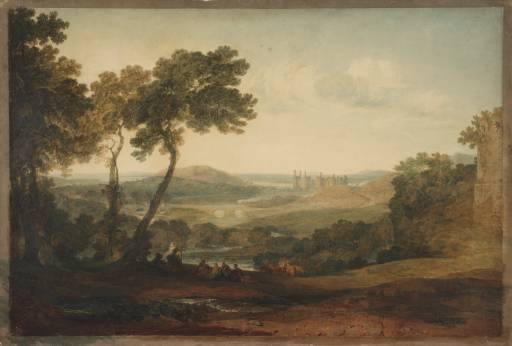Joseph Mallord William Turner Caernarvon Castle, North Wales exhibited 1800
Joseph Mallord William Turner,
Caernarvon Castle, North Wales
exhibited 1800
Joseph Mallord William Turner 1775–1851
Caernarvon Castle, North Wales 1800
D04164
Turner Bequest LXX M
Turner Bequest LXX M
Pencil and watercolour with gum Arabic, scraping- and stopping-out on white wove paper, 563 x 994 mm, mounted on thin board, washed grey, 700 x 1005 mm
Stamped in black ‘LXX – M’ bottom right
Stamped in black ‘LXX – M’ bottom right
Accepted by the nation as part of the Turner Bequest 1856
Exhibition history
1800
Royal Academy, London 1800 (351).
1974
Turner 1775–1851, Royal Academy, London, November 1974–March 1975 (43, reproduced in colour).
1984
Turner in Wales, Mostyn Art Gallery, Llandudno, July–September 1984, Glynn Vivian Art Gallery and Museum, Swansea, September–November (97, reproduced in colour).
1999
Turner in North Wales, 1799, Tate Gallery, London, November 1999–February 2000 (29).
2000
Turner: The Great Watercolours, Royal Academy of Arts, London, December 2000–February 2001 (12, reproduced in colour).
2001
William Turner: Licht und Farbe, Museum Folkwang, Essen, September 2001–January 2002, Kunsthaus Zürich, February–May (23, reproduced in colour).
2004
Turner yn y Gogledd / in North Wales 1799, National Museum and Gallery, Cardiff, October 2004–January 2005, Bodelwyddan Castle, July–September 2005 (no number).
References
1909
A.J. Finberg, A Complete Inventory of the Drawings of the Turner Bequest, London 1909, vol.I, p.176 LXX M (as ‘Caernarvon Castle North Wales. ... Probably the drawing exhibited R.A. 1800’).
1979
Andrew Wilton, J.M.W. Turner: His Life and Work, Fribourg 1979, pp.60 329 no.263, pl.52.
1983
Michael Kitson, ‘Turner and Claude’, Turner Studies, vol.2, no.2, Winter 1983, p.6.
1990
Kathleen Nicholson, Turner’s Classical Landscapes: Myth and Meaning, Princeton 1990, pp.52–4, fig.29.
This highly finished watercolour painting was exhibited at the Royal Academy in 1800 with the following verses in the catalogue, probably by Turner himself:
And now on Arvon’s haughty tow’rs
The Bard the song of pity pours,
For oft on Mona’s distant hills he sighs,
Where jealous of the minstrel band,
The tyrant drench’d with blood the land,
And charm’d with horror, triumph’d in their cries,
The swains of Arvon round him throng,
And join the sorrows of his song.
The Bard the song of pity pours,
For oft on Mona’s distant hills he sighs,
Where jealous of the minstrel band,
The tyrant drench’d with blood the land,
And charm’d with horror, triumph’d in their cries,
The swains of Arvon round him throng,
And join the sorrows of his song.
It was the first time that Turner had shown a historical subject in watercolour at the Academy, though he had for the past four years been submitting increasingly ambitious subject matter in that medium, including in 1799 a view of Caernarvon Castle (private collection)1 which treated the topographical subject as a grand sunset harbour scene in the manner of Claude Lorrain (1604/5–1682). The present author has argued that this large Caernarvon subject, with its crowd of figures listening to a Bard’s recitation, depicts Wales in peacetime, and that the large unfinished subject of an army marching through the mountains of Snowdonia (Tate D04168; Turner Bequest LXX Q) was intended as its wartime pendant.
Turner made many studies of dancing figures and of prophetic or Bardic old men in his Studies for Pictures sketchbook (Tate D04012–D04016, D04101; Turner Bequest LXIX 18–22, 87). There is also a study of a Bard playing his harp in the Dolbadarn sketchbook (Tate D01993; Turner Bequest XLVI 1). Other studies of figures possibly related to the subject occur elsewhere in that book. It seems likely that the large study or unfinished picture (Tate D04165; Turner Bequest LXX N) is a trial version of the same subject. This final version is based on a pencil study in the Lancashire and North Wales sketchbook (Tate D01986; Turner Bequest XLV 46), and the figures are imported or adapted from his other meditations on the theme. He unashamedly introduces extreme anachronism into his ancient Welsh scene: the Bard addresses his followers in a landscape that is plainly modern, with a handsome new house visible among the trees at the left, and the rigging of modern shipping visible in the river beside Caernarvon Castle, a huge fortification built by Edward I as part of his campaign to pacify Wales. Beyond Caernarfon are the low hills of Anglesey (Mona).
The legend of Edward’s vow to exterminate the Welsh Bards had been popular since Thomas Gray’s poem on the subject, The Bard, was published in 1757, though it is now considered a fanciful rather than authentically historical addition to the story. Turner may have been aware of a painting of the subject by Thomas Jones (1742–1803), in which the last of the Bards contemplates his murdered companions in a wild mountainous landscape derived from the more romantic scenes of Salvator Rosa (1615–1673). Into this entirely imaginary setting Jones introduces Stonehenge, thereby identifying the Bards with the Druids. Jones exhibited his picture at the Royal Academy in 1774 and presented it to a patron, Oldfield Bowles.
It is possible that Turner considered incorporating Stonehenge into his treatment of the subject; there are drawings of Stonehenge in the Studies for Pictures sketchbook (Tate D04090, D04092; Turner Bequest LXIX 79, 80a). He would have passed the stone circle in the course of his work in Wiltshire for both Sir Richard Colt Hoare and William Beckford; see the Introduction to the ‘Architectural and Other Subjects c.1797–1807’ section of this catalogue, and the Fonthill sketchbook, especially Tate D02178 (Turner Bequest XLVII 1).
Technical notes:
The margins show washes of colour from the subject itself
Andrew Wilton
May 2013
How to cite
Andrew Wilton, ‘Caernarvon Castle, North Wales 1800 by Joseph Mallord William Turner’, catalogue entry, May 2013, in David Blayney Brown (ed.), J.M.W. Turner: Sketchbooks, Drawings and Watercolours, Tate Research Publication, April 2016, https://www

